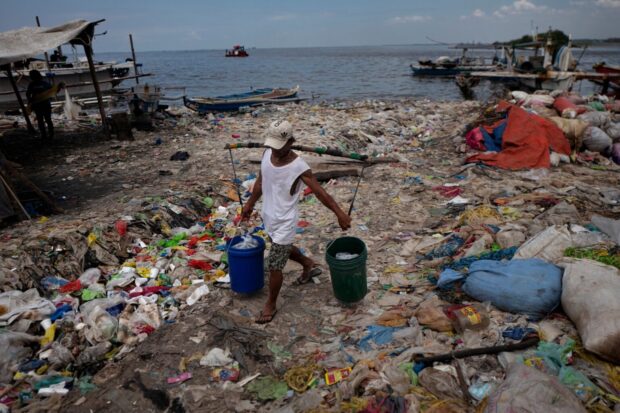Litigation could cost the plastics industry and its insurers $20 billion in the U.S. over the next eight years, according to a report backed by the United Nations and an Australian billionaire.
Companies including petrochemical and consumer goods firms may be liable for the cost of cleaning up plastic pollution, while emerging legal pathways to claim for the harm to society threaten to add to their corporate liabilities. Beyond 2030, legal claims “could be an order of magnitude larger.”
The report from Australian mining tycoon Andrew Forrest’s nonprofit Minderoo Foundation is the first time that lawyers and data analysts have modeled how the cost of plastic-related pollution translates into the likely compensation payouts.
The research is supported by the United Nations Environment Programme’s Finance Initiative, a collaboration between the UN and the finance industry.
More than 300 million tons of plastic are produced every year, and at least 14 million tons ends up in the ocean where it is ingested by animals and can enter the human food chain, according to the International Union for Conservation of Nature.
Like climate change-related risks, plastic pollution can impact the insurance industry through liabilities.
“Similar to fossil fuel companies and the climate impact of their products, plastic producers are the ‘pin-ups’ for having created the most extreme externalities ever witnessed in the history of mankind,” Forrest, who used to run a nickel miner, said.
Asbestos
The $20 billion figure is an order of magnitude smaller than losses the insurance industry has suffered from asbestos-related lawsuits. Credit ratings agency AM Best estimates these at $146 billion, but incurred over decades rather than from the first eight years of claims. Still, the report warns that plastics-related losses could ultimately be comparable in size.
Minderoo enlisted law firm Clyde & Co together with data group Praedicat to calculate the figure by tracing the value of environmental and human health damage, which is estimated to be hundreds of billions of dollars, through the existing legal avenues claimants could take to get compensation. Praedicat’s models attached probabilities to successful claims over the effect of chemicals found in plastics.
Some research has linked chemical additives in plastics to health problems such as infertility, early puberty, developmental issues and metabolic disorders. The report estimates that the global social costs associated with these plastic-related chemicals exceeds $100 billion a year. Using relevant legal precedents including some judgments in the recent opioids lawsuits, the researchers calculated expected liabilities of $20 billion in the U.S. Other legal pathways resulted in smaller corporate liabilities.
Future Costs
The large gap between the estimated social cost of plastic pollution and the more than $20 billion corporate liabilities is partly explained by the relative infancy of plastics litigation and test cases and the difficulty of linking harms to particular producers of plastic. Its supply chains include many actors and unlike with tobacco lawsuits, for example, most people have been exposed to polymers.
Underwriters and risk managers create models to simulate the real world and predict the likelihood of different future outcomes. The report estimates that insurers would need to account for the worst-case scenario of losses of $100 billion when planning for how much capital they need to hold. But the gap may narrow in the future as case law builds. There is a possibility of a large uptick in successful claims in the medium term, the report says.
The insurance and reinsurance industry make decisions with longer time horizons than investors and companies because they are calculating their exposures to future claims.
“In 10 years’ time, the legal cases might be far stronger, the science far more damning,” said Dominic Charles, director at the Minderoo Foundation.
Photo: (Photo by Jes Aznar/Getty Images)





















 NOAA Announces Latest AI-Driven Global Weather Models
NOAA Announces Latest AI-Driven Global Weather Models  Northern California Flooding This Weekend Caused by Heavy Rain, High Tides
Northern California Flooding This Weekend Caused by Heavy Rain, High Tides  Nearly Half of 100 Largest P/C Insurers Destroy Value: ACORD
Nearly Half of 100 Largest P/C Insurers Destroy Value: ACORD  Why ‘Good Enough’ Is Killing Insurance: The Hidden Cost of Satisficing
Why ‘Good Enough’ Is Killing Insurance: The Hidden Cost of Satisficing 





